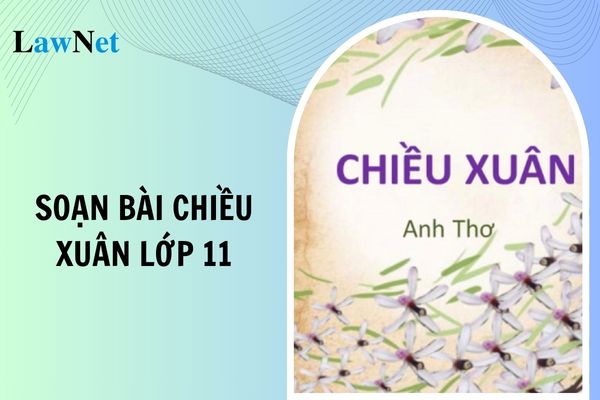Guidelines on preparing the lesson "Chiều xuân" for grade 11 students in Vietnam
Guidelines on preparing the lesson "Chiều xuân" for grade 11 students in Vietnam
|
Preparing the Lesson "Chiều xuân" for grade 11 Guidelines for Preparing the Lesson "Chiều xuân" for grade 11 1. Author Anh Tho |
Note: The content of preparing the lesson "Chiều xuân" for grade 11 is for reference only!

Guidelines on preparing the lesson "Chiều xuân" for grade 11 students in Vietnam (Image from the Internet)
What is the content of the Literature for grade 11 students in Vietnam?
Based on the General Education Program for the subject of Literature issued together with Circular 32/2018/TT-BGDDT, the content of the Literature for grade 11 students in Vietnam includes:
VIETNAMESE LANGUAGE KNOWLEDGE
-
Ways to interpret the meaning of words
-
Errors in sentence components and how to correct them
3.1. Rhetorical measures of structural repetition, contrast: characteristics and impacts
3.2. Some phenomena of breaking conventional language rules: characteristics and impacts
3.2. Types of documents and genres
- Argumentative documents: the relationship between the points, reasons, and evidence with the thesis; the suitability between the content and the title of the document; the writer's purpose, attitude, and emotions; the elements of explanation, narration, and expression in argumentative documents; essays on social issues; essays analyzing and evaluating an artistic work (literature, cinema, music, painting, architecture,...)
- Informational documents: the role of data and information in conveying the ideas, main content, or message of the document; some forms of summary informational documents; title, purpose, and attitude of the author; comprehensive explanatory essay; research report
3.3. How to present references in an essay or research report
4.1. Basic characteristics of written and spoken language
4.2. Nonverbal communication tools: images, data, charts, diagrams,...
LITERATURE KNOWLEDGE
1.1. The creative subject, the author’s attitude, and thoughts in the document
1.2. Documents with multiple themes, main and secondary themes; themes that reflect national cultural characteristics (nationalism) and themes that reflect universal characteristics (humanism)
1.3. Characteristics of literary language and the ambiguity of words in literary works
2.1. Characteristics of folk poetry, Nom poetry, modern short stories, tragedies, memoirs
- Elements of folk poetry and Nom poetry such as plots, characters, narrators, inner monologues, language description techniques,…
- Modern short stories: space, time, storyline, characters, narrators, perspectives and perspective shifts, narrator’s voice, character voice,…
- Tragedy: conflicts, actions, dialogues, characters, storyline, cathartic effects,…
- The combination of fictional and non-fictional elements in memoirs
- Essays or prose: lyrical self, structure, language,…
2.2. Internal and external conflicts
2.3. The meaning and effect of narrative elements in poetry
2.4. The role of symbolism in poetry. The aesthetic value of several formal elements in poetry: words, composition, the visual presentation on the page of the poem
3.1. How to compare two literary documents on the same topic
3.2. Basic knowledge about Nguyen Du to assist in comprehending some of his notable works
3.3. The author's viewpoint and the reader's perspective
LINGUISTIC MATERIAL
1.1. Literary documents
- Epics, modern short stories, and novels
- Poetry, Nom poetry
- Tragedy
- Memoirs, essays or prose
1.2. Argumentative documents
- Social arguments
- Literary arguments
1.3. Informational documents
- Explanatory documents incorporating multiple elements such as description, narration, expression, reasoning
- Research reports
Which Circular stipulates the formula for calculating the average score of the Literature for grade 11 students in Vietnam?
According to Article 21 of Circular 22/2021/TT-BGDDT:
Effective Date
- This Circular takes effect from September 5, 2021, and will be implemented according to the following schedule:
- From the academic year 2021-2022 for Grade 6.
- From the academic year 2022-2023 for Grades 7 and 10.
- From the academic year 2023-2024 for Grades 8 and 11.
- From the academic year 2024-2025 for Grades 9 and 12.
- This Circular replaces Circular No. 58/2011/TT-BGDDT dated December 12, 2011, of the Minister of Education and Training promulgating the Regulation on Assessment and Classification of Secondary and High School Students, and Circular No. 26/2020/TT-BGDDT dated August 26, 2020, of the Minister of Education and Training amending and supplementing some articles of the Regulation on Assessment and Classification of Secondary and High School Students promulgated together with Circular No. 58/2011/TT-BGDDT dated December 12, 2011, of the Minister of Education and Training, according to the schedule specified in Clause 1 of this Article.
Thus, the Circular 22/2021/TT-BGDDT stipulates the formula for calculating the average score of the Literature for grade 11 students in Vietnam.

